4.3 Exercise 3: Using the Type Tool to create a headline
xtine burrough and Michael Mandiberg
Headlines are typically larger than body copy and maintain a heavier weight on the page than most other elements. The scale of the headline often relates to the scale of an accompanying photograph or illustration (it may be the same width or half of the width, for example, as a photograph on the front page of a newspaper). System fonts (the fonts that are installed on all computers, such as Arial, Chicago, Times, New York, and so on) are usually reserved for the body copy on web pages; and they are not typically used as headlines. For print designers, it is a good idea to stay away from system fonts! Web designers have to rely on them for body copy. Display fonts (ornamental fonts, such as those that are free to download on (http://chank.com/freefonts.php) are not legible enough to be used for body copy, but are often selected for headlines as they tend to be more ornate. Sans serif type was first invented by William Caslon IV (1816) and was reserved, as John Kane writes in his A Type Primer, “almost exclusively for headlines” (36). Using a sans-serif font for headlines is not a rule, but often commands attention as they are sleek and authoritative in comparison to serif fonts. In this exercise, Gill Sans was the typeface used for both the headline and the body copy. The ultra-bold font style creates a weighty headline, and the regular variation of the typeface is very easy to read as body copy.
- Select the Type Tool in the Tool Palette (shortcut key T)
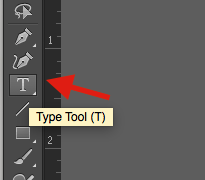
The location of the Type Tool on the Tool Bar - Click anywhere on the Artboard with the type tool. Do not drag. Clicking just one time will change the Type Tool into a flashing cursor. When you see the flashing cursor begin typing the headline, “Grid Systems.” Illustrator® is a smart program, but it doesn’t know when you are finished using the type tool. You have to tell it “I’m done;” and there are many ways to do this (see the sidebar). When you are finished typing your headline, click on the Selection Tool. The type is automatically selected as an object and the flashing cursor is gone.
Tip – How to tell Illustrator® you are done using the Type Tool: 1. Hold CMD and click anywhere outside of the type on the Artboard. The type is now deselected. 2. Press the Escape Key on the keypad. Notice your Selection Tool is automatically activated.
- Once the type is created, it can be edited by using the Selection Tool and the Control Palette or the Character Palette. If your type is not selected, click on it with the Selection Tool.
- In this exercise, Gill Sans Ultra Bold was used for the headline. While the type is selected, choose Gill Sans Ultra Bold (if you have it installed) or any other font of your choice from the Character pull-down menu either from the Control Palette or from the Character Palette (Window >Type > Character).
- The font size can be edited by typing a number into the font size box in the Control or Character Palette or by scaling the type with the Selection Tool. To scale the type, click on any of the four anchor points at the corners of the selected type object and drag towards (decreases the scale) or away from (increases the scale) the center of the type while holding SHFT. In this exercise, the headline is 44 points.
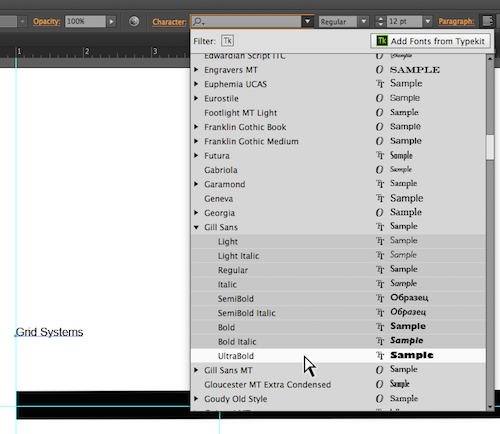
Menu of font choices - Use the Selection Tool to pick up the headline and move it so that the baseline is within the black line and the S in Systems is just to the right of the vertical guide.
The word “baseline” refers to the invisible line upon which typographic letters rest, as demonstrated here:
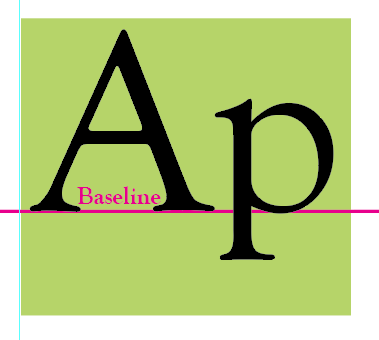
‘A’ and ‘P’ on a baseline - Kerning is the space between the letters in a single word. When you set body copy (for instance, a letter typed in Microsoft Word), you usually do not have to be concerned with kerning. The digital fonts are created to be well-kerned at smaller font choices (such as 10 – 12 points). However, when working with display text, such as a 44 point headline, the kerning should be studied. Traditionally, the amount of space between each letter should be even.In this exercise, we will adjust the space between the i and r in Grid and the s and t as well as the t and e in Systems. Place the type cursor just between the i and r in the word, Grid. Click when you see that the cursor looks like a single line so that you are able to edit the word.
Watch Out: If you accidentally click when the Type Tool looks like a T with a dotted-box around it, you will make a new type object. If you accidentally create a type box use the Selection Tool to select it and then hit the Delete Key on your keypad.
Once the Type Tool is between the i and the r in Grid, use OPT + the Right or Left Arrow keys on the keypad to nudge the letters to the left or right. This is the method of manually adjusting the kerning of the display text in Illustrator®, Photoshop® and InDesign®. Repeat this for the s/t and t/e in the word, “Systems”. If you have used a different font you may need to adjust kerning between other letters. Be sure to save your work!
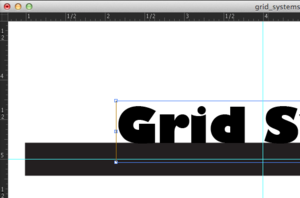
The two images demonstrate the word “Grid” before and after kerning. Above is before kerning. 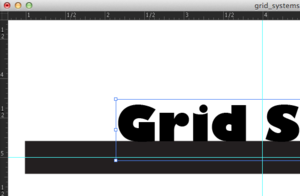
After kerning Be sure to save your work often!

